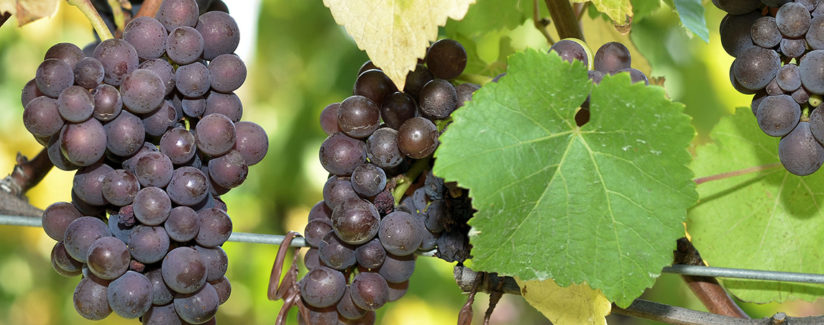
The World of Winemaking
07/25/2016
As Billy Joel sang, “Bottle of red, bottle of white – it all depends upon your appetite.” But appetite isn’t the only thing to consider. Red vs. white, French vs. Italian, dry vs. sweet, healthy vs. unhealthy – there are a lot of opinions to be had when it comes to wine, but something rarely thought about is the science of wine. For the uninitiated, the process of making wine – or enology – is extremely scientific. But before enology is even possible, there’s viticulture – the study of grapes and all aspects of grape production.
To help us on our journey of becoming master sommeliers (just kidding), we reached out to Dean Volenberg, PhD, Director, Grape and Wine Institute and Assistant Extension Professor, Viticulture and Winery Operations, from the University of Missouri’s College of Agriculture.
So, what exactly is viticulture? What is enology?
Dr. Volenberg: “Viticulture is the study of grapes and involves all aspects of grape production. There are a number of production aspects to consider: nutrient management, rootstocks, pruning, training systems, canopy management, pest management, water management, i.e. irrigation, and fruit quality. Within all these production parameters are sciences that move the viticulture industry forward. For example: soil science provides research on nutrient management, grape breeding research improves cultivars or creates new cultivars and new rootstocks, viticulture research examines a number of things including training systems, canopy management, etc…
“Enology is the science of wine making. Once the grapes are harvested, the enologist “takes over” and the process of winemaking begins. However, the winemaker also plays a critical role in determining the harvest parameters in the field based on the type of wine being made. Even though viticulture and enology are separate sciences, the winemaker needs to also be educated in the science of viticulture and the grape grower or “viticulturist” also needs to know about the winemaking processes. Both the grape grower and winemaker work together. Winemaking involves a lot of chemistry and an understanding of fermentation sciences, which involves an understanding of microbiology.”
There’s more science to your favorite glass of Pinot than you thought…
We always knew wine was complex, but we’d be lying if we said we always thought of winemaking as a science. While France and Italy are known around the globe for amazing wines, we were interested in learning about wine production at home here in the U.S. According to Dr. Volenberg, here in the United States, it’s all about matching cultivars to climate and introducing new cultivars.
Dr. Volenberg: “One of the limitations of the grape industry in the Midwestern United States and other areas that experience severe winter cold was cold-hardiness. However, most of this was overcome by breeding the North American grape (Vitis riparia) with other grape cultivars that have excellent grape quality to be expressed in wine. Grape breeders are also looking for grape selections that bud out later in the spring to avoid the dangers of spring frost events.”
So, technically, wine can originate from any climate – as long as the grape cultivar matches the climate. For example, Dr. Volenberg says, “Many of the grape cultivars developed in Minnesota develop too early when planted in central or southern Missouri. Many of these cultivars mature in August during peak periods of heat and this reduces the fruit quality. Cultivars that mature later in the season as the weather cools produce higher quality grapes.”
So, how do wines from different climates/geographical regions differ?
Dr. Volenberg tells us that grapes are currently grown in all 50 states in the United States. The varietals that are best for making wine are the grapes that grow best in your area.
Dr. Volenberg: “The grape cultivars are different in geographical areas. Areas that grow vinifera cultivars in warm areas (California) have to deal with high sugars and high pH’s during winemaking. In the Midwest and other areas that grow French American hybrids, the winemakers have to deal with relatively high total acidity and low tannins and some years, low brix (sugar). Winemakers are scientists and artists and deal with what nature has provided. They let the grape, the ripeness all dictate what style of wine the grape will be used for.”
Most of us are most familiar with wines such as Merlot, Cabernet Sauvignon or Chardonnay. According to Dr. Volenberg, these wines are made with Vitis vinifera cultivars or “old world cultivars that can only be grown in areas that do not experience severe cold winter temperatures.” In the United States, these are areas such as California, Oregon, Washington, Texas, areas of New York near Lake Erie, areas of Michigan by Lake Michigan and others. In regions that generally experience cold winter temperatures greater than 10 degrees Fahrenheit below zero, both native North American grapes and hybrid grape cultivars can be grown.
Regardless of where it’s from or what grape cultivar is used, the winemaking process is the same for most wines. All wine is made from grapes after the sugars in the grapes have been fermented into alcohol. Winemaking is equal parts science and art. There are many decisions that go into making a bottle of wine. How long should the grape juice be fermented? How dry should it be? Should there be any residual sugar? Does the wine have enough body to stand alone or should it be blended? Because there are so many decisions that go into making wine, there are also many different outcomes. Dr. Volenberg tells us that new grape cultivars are being tested and released all the time, which means new wine “varietals” are always coming out. There will always be a wine varietal and style for every consumer taste!
The image “Pinot Grigio prior to harvest, vintage 2012” by Stefano Lubiana is licensed under CC BY 2.0.

























